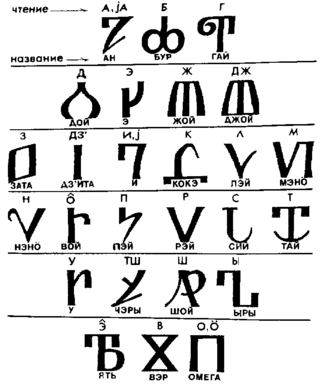Music
- Cyrillic (album), 2010 jazz album
Cyrillic refers to the Cyrillic script. It may also refer to:

The Cyrillic script, Slavonic script or simply Slavic script is a writing system used for various languages across Eurasia. It is the designated national script in various Slavic, Turkic, Mongolic, Uralic, Caucasian and Iranic-speaking countries in Southeastern Europe, Eastern Europe, the Caucasus, Central Asia, North Asia, and East Asia, and used by many other minority languages.

The Glagolitic script is the oldest known Slavic alphabet. It is generally agreed to have been created in the 9th century by Saint Cyril, a monk from Thessalonica. He and his brother Saint Methodius were sent by the Byzantine Emperor Michael III in 863 to Great Moravia to spread Christianity among the West Slavs in the area. The brothers decided to translate liturgical books into the contemporary Slavic language understandable to the general population, and Cyril decided to invent a new script, Glagolitic, which he based on the local dialect of the Slavic tribes from around Thessalonica. After the deaths of Cyril and Methodius, the Glagolitic alphabet ceased to be used in Moravia for political or religious needs.

Various Mongolian writing systems have been devised for the Mongolian language over the centuries, and from a variety of scripts. The oldest and native script, called simply the Mongolian script, has been the predominant script during most of Mongolian history, and is still in active use today in the Inner Mongolia region of China and has de facto use in Mongolia.
The Coptic script is the script used for writing the Coptic language, the latest stage of Egyptian. The repertoire of glyphs is based on the uncial Greek alphabet, augmented by letters borrowed from the Egyptian Demotic. It was the first alphabetic script used for the Egyptian language. There are several Coptic alphabets, as the script varies greatly among the various dialects and eras of the Coptic language.

The Early Cyrillic alphabet, also called classical Cyrillic or paleo-Cyrillic, is a writing system that was developed in Medieval Bulgaria in the Preslav Literary School during the late 9th century. The modern Cyrillic script is used for some Slavic languages, and for East European and Asian languages that have experienced a great amount of Russian cultural influence.

The Persian alphabet, also known as the Perso-Arabic script, is the right-to-left alphabet used for the Persian language. It is a variation of the Arabic alphabet with four additional letters added: پ چ ژ گ. It was the basis of many Arabic-based scripts used in Central and South Asia. It is used for the Iranian and Dari standard varieties of Persian; and is one of two official writing systems for the Persian language, alongside the Cyrillic-based Tajik alphabet.

The Sogdian alphabet was originally used for the Sogdian language, a language in the Iranian family used by the people of Sogdia. The alphabet is derived from Syriac, a descendant script of the Aramaic alphabet. The Sogdian alphabet is one of three scripts used to write the Sogdian language, the others being the Manichaean alphabet and the Syriac alphabet. It was used throughout Central Asia, from the edge of Iran in the west, to China in the east, from approximately 100–1200 A.D.

The Old Permic script, sometimes known by its initial 2 characters as Abur or Anbur, is a "highly idiosyncratic adaptation" of the Cyrillic script once used to write medieval Komi.
Unicode has subscripted and superscripted versions of a number of characters including a full set of Arabic numerals. These characters allow any polynomial, chemical and certain other equations to be represented in plain text without using any form of markup like HTML or TeX.
As of Unicode version 15.1, Cyrillic script is encoded across several blocks:

Zhje or Zhe with descender is a letter of the Cyrillic script. Its form is derived from the Cyrillic letter Zhe with an addition of a descender on its right leg.
Unicode supports several phonetic scripts and notations through its existing scripts and the addition of extra blocks with phonetic characters. These phonetic characters are derived from an existing script, usually Latin, Greek or Cyrillic. Apart from the International Phonetic Alphabet (IPA), extensions to the IPA and obsolete and nonstandard IPA symbols, these blocks also contain characters from the Uralic Phonetic Alphabet and the Americanist Phonetic Alphabet.
Phonetic Extensions is a Unicode block containing phonetic characters used in the Uralic Phonetic Alphabet, Old Irish phonetic notation, the Oxford English dictionary and American dictionaries, and Americanist and Russianist phonetic notations. Its character set is continued in the following Unicode block, Phonetic Extensions Supplement.

The Latin script, also known as the Roman script, is an alphabetic writing system based on the letters of the classical Latin alphabet, derived from a form of the Greek alphabet which was in use in the ancient Greek city of Cumae, in southern Italy. The Greek alphabet was altered by the Etruscans, and subsequently their alphabet was altered by the Romans. Several Latin-script alphabets exist, which differ in graphemes, collation and phonetic values from the classical Latin alphabet.

Abkhazian Che is a letter of the Cyrillic script.
The ISO basic Latin alphabet is an international standard for a Latin-script alphabet that consists of two sets of 26 letters, codified in various national and international standards and used widely in international communication. They are the same letters that comprise the current English alphabet. Since medieval times, they are also the same letters of the modern Latin alphabet. The order is also important for sorting words into alphabetical order.
Gothic or Gothics may refer to:
Circle symbol may refer to :